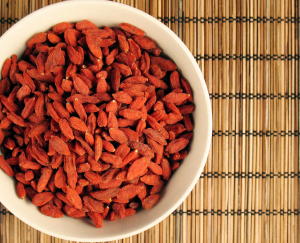Search Healthnotes

Related Topics
-
Superfoods to the Rescue
-
Discover the Pleasure of Cooking with Fresh Herbs
-
Beautiful, Bountiful Berries
-
What’s for Dinner Tonight?
-
Give Chai a Try
- By Judith H. Dern
Goji Berry—A Modern Look at an Ancient Superfruit
Prized for their remarkable quantities of nutrients and antioxidants, goji berries have been important in traditional Chinese medicine for nearly 2,000 years. Westerners love the berries in juice, smoothies, trail mix, cookies, or simply as a snack.
Whether eaten by the handful or tossed into salads and smoothies, goji berries are versatile and tasty with a tangy–sweet flavor
Goji berry’s healthful history
An old Chinese tale told a village where people never got sick. A bush with spreading vines grew beside the village well, dropping its berries into the water. Village elders determined the berries added healthful elements to the drinking water, keeping everyone healthy. Whether this was the first clue to the goji berry’s vast nutritional resources is unknown, but it’s certain that gojis are positively packed with nutrients and phytochemicals.
In traditional Chinese medicine, goji berries are believed to enhance a person’s longevity, build strength, and aid sexual potency. Research has yet to confirm any health claims with regard to goji berries, and some foreign sources of the berry show pesticide contamination, but the little fruit is generally considered a superfood, as it is a rich source of:
- Antioxidants, which may enhance functioning of the immune system, contribute to the wellness of the kidneys and liver, and help guard against free radicals associated with cancer and the aging process.
- Carotenoids, especially beta-carotene, which may help prevent cataracts and heart disease, plus zeaxanthin, a dietary carotenoid aiding eye function.
- Vitamins B1, B2, B6 and E, all essential to a range of good body health from processing amino acids and fats, to converting carbohydrates to energy.
- 11 amino acids and 22 minerals including zinc, iron, copper, calcium, and selenium.
- Polysaccharides, which some have suggested might help to fortify the immune system, treat inflammation, and help reduce some forms of skin disease.
Easy tips to get more goji
Are goji berries the new raisin? Naturally dried and delicious, the small, chewy red–orange berries taste like a cross between cranberries and cherries. Whether eaten by the handful or tossed into salads and smoothies, goji berries are versatile and tasty with a tangy–sweet flavor. While there is no prescribed daily amount, a small handful or 1/4 cup (approximately 40 grams) is considered an average portion.
- Mix into the fruit filling for a blueberry, raspberry, peach, rhubarb, or strawberry pie.
- Toss into a wild rice salad or rice stuffing instead of dried cranberries.
- Substitute for raisins in trailmix.
- Stir into a morning bowl of oatmeal or other hot cereal.
- Blend into a puréed carrot–orange soup.










